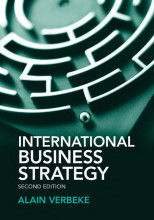Summary: International Business Strategy | 9781107027893 | Alain Verbeke
- This + 400k other summaries
- A unique study and practice tool
- Never study anything twice again
- Get the grades you hope for
- 100% sure, 100% understanding
Read the summary and the most important questions on International Business Strategy | 9781107027893 | Alain Verbeke
-
1 Core concepts
This is a preview. There are 2 more flashcards available for chapter 1
Show more cards here -
What is international strategy?
Matching a multinational enterprise's (MNE's) internal stregths:- With the opportunities and challenges found in cross-border environments
- While overcoming the disadvantages of being a foreign company
- And/or capitalizing on the advantages of being a foreign company
- And/or capitalizing on the advantages of having an international network.
-
1.1 Elements of international strategy (Benito, 2015)
This is a preview. There are 4 more flashcards available for chapter 1.1
Show more cards here -
What are the elements of international strategy?
- Why
- Where
- What
- How
- Why
-
Market seeking (core activity, why, where, how, performance)
- Marketing and sales
- to find new customers
- seek location with: large population, densely populated, high purchasing power
- setting up own subsidiary
- volumes sold, sales growth, market share
- Marketing and sales
-
Efficiency seeking (core activity, why, where, how, performance)
- Manufacturing
- to lower costs of performing economic activites or raiionalizing their already existing operations in various locations
- Cost levels, availability of human resources, well developed infrastrucutre and proximity to home country
- -
- cost-profit margins, productivity
- Manufacturing
-
Resource seeking (core activity, why, where, how, performance)
- Extratction and production
- to access resources that are not readily available ate home or that can be obtained at a lower cost abroad
- availibilty over resoures (are not evenly distributed geographically)
- -
- inputs costs, price-cost margins, stability and relaiblity of supplies
- Extratction and production
-
Strategic asset seeking (core activity, why, where, how, performance)
- R&D, innovation
- to obtain strategic assets which may be critical to thier long term strategy but that are not available at home
- existence of vibrant clusters, high level of development, urban centres. They are forward looking, not looking to exploit existing resources thus seek diverse and dynamic environments that are simultaneously able to both continually produce high innovation rates and to absorb failures
- get there first
- new patents or other intellectual property, introduction of new products or processes
- R&D, innovation
-
1.2 Foundations of international strategy
This is a preview. There are 9 more flashcards available for chapter 1.2
Show more cards here -
What are the 7 foundations of international business strategy?
Internationally transferable FSAs (non-location bound)Non-transferable FSAs (location bound) Location advantagesInvestment in and value creation through resource recombinationComplementary resources of external actorsBounded rationalityBounded reliability- (advantages of foreignness)
-
What are the FSAs transferable & Non-transferable resource bases?
- Physical resources
- Financial resources
- Human resources
- Upstream knowledge
- Downstream knowledge
- Administrative knowledge
- Reputational resources
- Physical resources
-
What is recombination capabilities?
The ability to adapt and recombine resources in such a way that they maintain firm competitiveness over time and across environments. -
What is complementary resources of external actors?
MNEs need complementary resources of external actors (technology providers, licensees, local distributors, partners, etc.) to be successful abroad. You cannot do everything on your own beacause of cultural, economic, institutioanl and spatial distance.
- Higher grades + faster learning
- Never study anything twice
- 100% sure, 100% understanding































